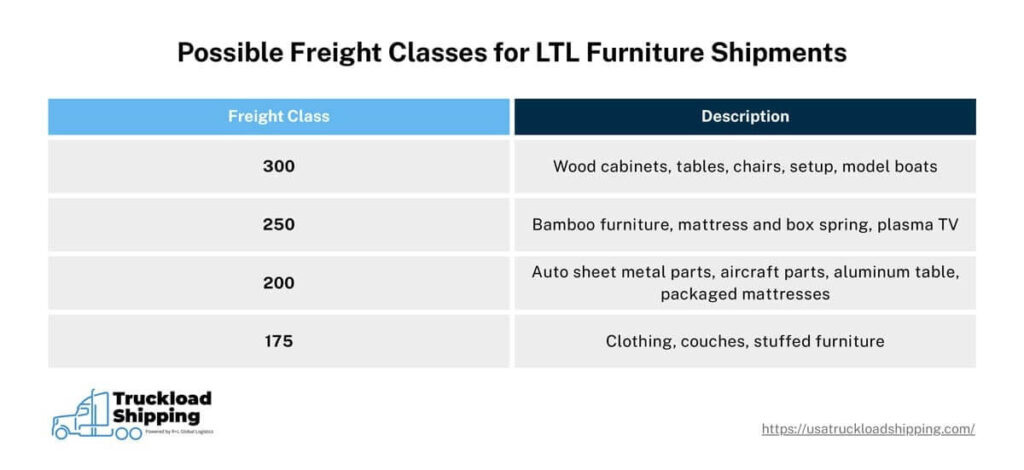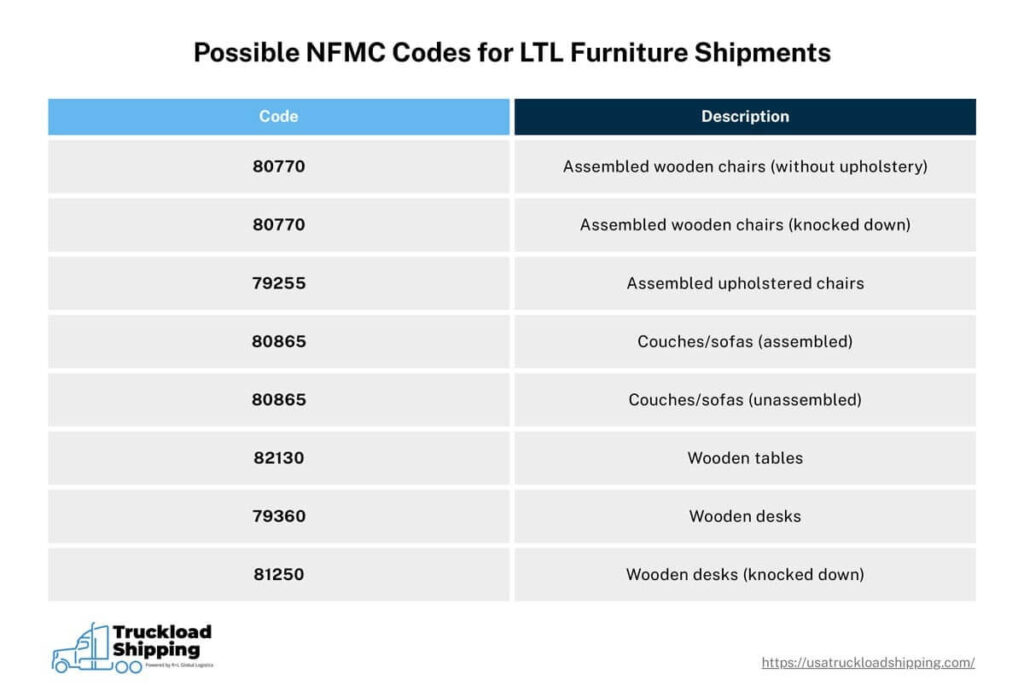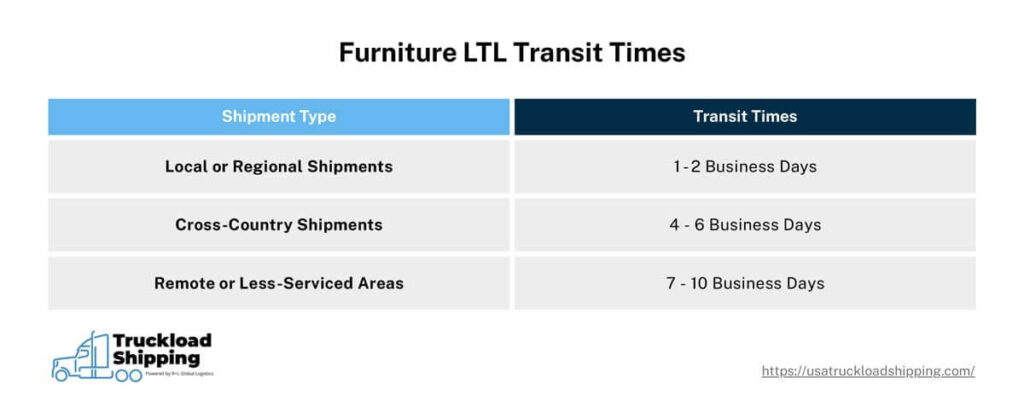Shipping furniture is full of challenges. It can be costly, and there’s always the chance your freight could be damaged while in transit. This can make finding the right solution for your cargo is extremely difficult. Fortunately, LTL shipping is a great solution that can address these concerns. Here’s what you need to know.
Key takeaways:
Let’s take a closer look at these points to better understand how LTL will help you ship furniture.
Furniture, whether prebuilt or flat-packed, is often heavy and awkward to ship. That combination also makes the process very expensive. Depending on your business model, shipping a full truckload may be impractical physically and financially, especially if you need to distribute to more than one location.
LTL, or less-than-truckload, is a more cost-effective way of transporting high value freight to multiple locations or when multiple stops are needed. With this mode of shipping, your furniture will be mixed in with other shipments. This means you won’t be paying for the space of an entire trailer.
Like other methods of shipping, you can add on other LTL services to your shipment. LTL also provides flexibility in terms of the size of your shipments and frequency you require transportation services.
Related: Difference Between FTL and LTL
Using LTL to move your furniture is pretty straightforward. We’ll show you how to set up your shipment in the following sections.
Packing your furniture for LTL shipping requires the completion of multiple steps. Some steps will depend on how far a piece can be broken down or whether it’s shipped in a box as a flat pack item. For instance, certain couches and tables must be shipped as whole pieces.
First, detachable parts on your furniture should be removed prior to shipping. This might make them easier to palletize later on, as well as prevent damage to more delicate pieces.
Parts that should be removed or separated include:
You should wrap all detachable parts carefully to give them adequate protection. Don’t try to forcibly remove these pieces if they’re supposed to stay on the furniture. The hardware needed to reassemble the detachable parts, like screws, bolts, and other small pieces, should be labeled and bagged.
Certain parts of your furniture, like the corners, may require additional protection. You can provide this by putting small strips of cardboard on these sections of the furniture.
The use of a clear plastic cover over the furniture serves as a layer of protection from debris and possible surface damage. Alternatively, you can use blanket wraps instead of plastic film.
When possible, boxing furniture serves as another layer of protection. Furniture can come in all shapes and sizes, so take measurements carefully to find a suitable box. Once the furniture is inside, you’ll need to fill in any empty space with extra cushioning.
You should also label your furniture appropriately. Doing so notifies workers that your freight should be handled with care and ensure items are delivered to the correct locations.
The final step is to palletize your furniture. With boxed furniture, it’s a simple process. Protecting larger, or more awkwardly shaped pieces, may require the use of custom pallets. The goal is to make it easier for workers to load and unload it from the trailer. The floor of a trailer can also be covered in dirt and even spilled liquids. A pallet will keep your freight slightly elevated off the floor.
All LTL freight shipments must be accompanied by a corresponding freight class and NMFC code. Both are used to calculate the costs of your LTL furniture shipment. Here’s how each one works.
There are 18 total freight classes, but I’ve provided the ones that will most likely apply to your LTL shipment of furniture.

There are nearly 18,000 different NMFC codes. Since there’s so many to choose, we’ve narrowed the list down to the codes that are most commonly applied to LTL shipments.

The reality is that shippers rarely select their own correct freight class and NMFC code. Although there are ways to estimate the freight class, the code assigned to your shipments will be determined by the LTL carrier using a system put in place by the National Motor Freight Traffic Association (NMFTA).
Struggling to find the freight class or NMFC code for your furniture shipment? Meet with one of our shipping specialists to determine which ones apply to your furniture during a consulting session.
Shipping documents are essential for LTL furniture shipments. We’ve listed the paperwork you’ll need to provide:
Your BoL, fright bill, and packing list must provide detailed information about the furniture you’re shipping. This includes the freight class and NMFC code. Incorrect information about your furniture could result in complications for your shipment, such as delays and surprise charges.
Make sure to double-check your shipping documents to ensure everything is correct.
Now that your freight is packed, and you have your documentation, you can move on to booking your shipment. This will involve filling out a quote request with your chosen transportation provider.
Among the details you’ll need to provide are:
Once you’ve accepted the price quoted for your furniture, you’ll only need to gather your documents and make your freight available for pickup at the specified date and time. It’s at this stage that your freight class and NMFC code get finalized.
Once you have an established relationship with a carrier or broker, you’ll likely be assigned to a client specialist or executive. This will make arranging loads easier and can pave the way for long-term contracts if you need routine services.
Here at USA Truckload Shipping, we work with a variety of carriers that specialize in furniture transportation and provide you with long term solutions.
While LTL shipping is beneficial for furniture shipping for many reasons, it can fall short when it comes to transit times. LTL freight shares trailer space with cargo belonging to other customers. That means the truck delivering your furniture must stop at multiple locations before reaching the final destination of your shipment.
This can stretch out transit times considerably. We’ve provided some estimated transit times for LTL furniture shipments.

Of course, this can work out to your benefit as well. If you need to restock or fulfill store orders from a central hub, using LTL shipments can actually reduce transit times.
Suppose you maintain the inventory in a warehouse located in western Massachusetts. From there, you use LTL services to restock brick and mortar stores in main cities through the New England Area. Unique orders at multiple stores can be fulfilled at almost the same time because you aren’t waiting to fill an entire truckload and then send that truck out to complete deliveries one at a time.
In either case, keep these transit times in mind so you can provide your customers with realistic expectations regarding the arrival time of their furniture.
The large dimensions of furniture can make it difficult to deliver. Fortunately, there are some additional services that you can use to make this process easier.
Use of these services may depend on whether you are shipping directly to the end consumer (B2C) or to another business (B2B). Distributing to a business is less likely to require these services, as their own employees may be available to handle such matters.
White glove delivery is a service that brings freight into the home of a customer. It’s frequently used when shipping furniture, appliances, or other high value household items. The company performing the service will unpack and assemble the delivered furniture.
Afterward, they’ll place it in an area of specified by the customer. Using white glove delivery will add between $100 and $300 to your LTL furniture shipment. That said, it can be well worth it, as your customer is likely to be impressed by your willingness to provide this service for their convenience.
If your furniture is being delivered to a location where dock loading or unloading can’t be performed, you’ll need to add liftgate services to your shipment. A liftgate is a movable platform on the back of a trailer or truck.
The driver will lower it onto the ground, move your furniture onto it with a pallet jack, and raise liftgate back up. If the liftgate is needed at the final destination, they’ll perform the same procedure in reverse.
Using this service typically costs between $50 and $150, but can sometimes be as high as $540. Despite the increase, it’s a service that’s absolutely necessary when you don’t have a loading dock.
This is more common in a B2C environment, but might also apply to small businesses that lack docking facilities.
Here at USA Truckload Shipping, we can provide LTL transport for your furniture and other personal belongings. We use a network of reliable small carriers that will handle your shipments with care. Our network also has enough capacity to pick up and transport your furniture anywhere in the United States. Here’s a quick look at the services we can offer.
If you’re ready to ship your furniture with LTL, then fill out your USA Truckload Request for Proposal (RFP). Once you’ve completed this document, you’ll have long-term access to our transportation services. For more information about the services we provide, call our team at (866) 353-7178 or reach out to us on our contact page.
R+L Global Logistics
315 NE 14th St., Ocala, FL 34470